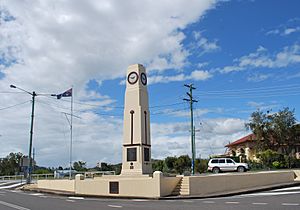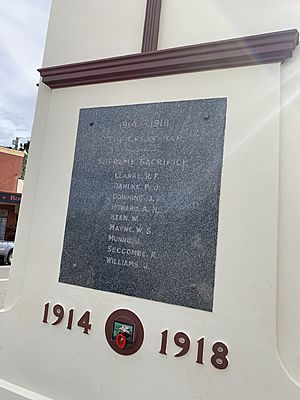Goomeri War Memorial Clock facts for kids
Quick facts for kids Goomeri War Memorial Clock |
|
|---|---|

Goomeri War Memorial, 2010
|
|
| Location | Burnett Highway, Goomeri, Gympie Region, Queensland, Australia |
| Design period | 1939 – 1945 (World War II) |
| Built | 1940 |
| Official name: Goomeri War Memorial Clock | |
| Type | state heritage (built) |
| Designated | 21 October 1992 |
| Reference no. | 600642 |
| Significant period | 1940– (social) 1940 (historical) 1940(fabric) |
| Significant components | memorial surrounds/railings, memorial – clock tower, flagpole/flagstaff |
| Builders | Ernest Gunderson |
| Lua error in Module:Location_map at line 420: attempt to index field 'wikibase' (a nil value). | |
The Goomeri War Memorial Clock is a special monument located in Goomeri, Queensland, Australia. It was built in 1940 to remember the brave soldiers from the area who served in the First and Second World Wars. This clock tower is an important part of Goomeri's history. It is officially listed on the Queensland Heritage Register.
Contents
History of the Goomeri War Memorial Clock
Building the Memorial
The Goomeri War Memorial Clock was officially revealed on November 15, 1940. A leader from the RSL (Returned and Services League) helped with the ceremony. The clock tower was built to honor local men who died in the First World War and the Second World War.
At first, it listed the names of those who died in the First World War. Later, the names of those who died in the Second World War were added. Building the memorial cost about £700. This money was raised by the local Goomeri RSL group.
Why War Memorials Were Built
Before the First World War, Australia did not have many public monuments. After the war, many memorials were built. These became Australia's first national monuments. They showed the huge impact the war had on the country. Australia lost 60,000 people from a population of about 4 million. This meant one in five of those who served died. No other war has affected Australia so much.
Even before the war ended, people started building memorials. They were a way to show national sadness. For those who built them, these memorials were like sacred graves. They were substitute graves for Australians buried overseas. The word "cenotaph" means "empty tomb." This word was often used for war memorials.
Unique Australian Memorials
Australian war memorials are special because they honor everyone who served. They do not just remember those who died. Australians were proud that their army was made of volunteers. These men were honored whether they died or not. Many memorials list all who served from a town. This shows how much the community was involved in the war.
Australian war memorials also show loyalty to the British Empire and Australia. They show the skills of local builders and artists. In Queensland, statues of a "digger" (an Australian soldier) were popular. In southern states, tall, thin obelisks were more common. Many First World War monuments have been updated. They now include local people who served in later wars.
The Clock Tower Design
Many different types of war memorials were built in Queensland. However, clock tower memorials were quite rare. We do not know who designed the Goomeri memorial. But the metal parts were made by Ernest Gunderson. These metal parts were actually from an earlier monument. That monument also honored the First World War.
Ernest Gunderson started his metalworking company in Brisbane. He moved there from Norway. His company worked until the mid-1930s. It made honor boards and plaques for memorials all over Queensland. His work was very original. It often included both Australian and British designs. The monument is painted, and some details are now darker.
Description of the Goomeri War Memorial Clock
The Goomeri War Memorial Clock is in the middle of a traffic island. This island is at a main intersection in Goomeri. The clock tower is very tall and can be seen from most places in town. The traffic island is level with the road on one side. A flagpole stands near the monument. The monument sits on a stepped concrete base. There are short, square concrete bollards at each corner of the base.
The painted concrete monument is about 74 feet tall. It has a tower that gets narrower towards the top. There are clock faces at the very top. Metal pieces from Goomeri's old First World War memorial are attached to the tower. The tower has three main parts: a base, the main body, and the clock section.
Base Details
The base has simple molded designs. A strong metal door is set into the north side. This door has a bronze Australian Coat of Arms. It is surrounded by a laurel wreath. The dates "1914" and "1919" are above and below the wreath in bronze.
On the other sides of the base are shiny granite plaques. These plaques have the names of those who died engraved on them. The south side lists the nine names from the First World War. It also has the dates "1914 – 1919." The west side shows the twelve names from the Second World War. The east side is blank.
Tower Body and Clock
Above the base is the main body of the tower. It is plain except for a simple decoration painted dark brown. The top part of the body has flat corners. These corners continue up into the clock section.
The clock is at the very top of the tower. It has four faces that light up at night. Instead of numbers, the words "Lest we forget" are written on each clock face. You can read them by going clockwise.
Why the Goomeri War Memorial Clock is Important
The Goomeri War Memorial Clock was added to the Queensland Heritage Register on October 21, 1992. It is important for several reasons:
Showing Queensland's History
War memorials like this one show how Queensland's history has changed. They represent a common theme in many communities. They also show a time when Australians felt very patriotic and proud of their country. This was especially true during and after the First World War. The memorial also shows the special work of Brisbane metalworker Ernest Gunderson.
A Rare and Unique Memorial
This clock tower is one of only a few memorials in Queensland that is shaped like a clock tower. It also has special decorative features that are not common.
Showing Key Features of War Memorials
These monuments are a unique historical record. They show what people liked in terms of design between the two World Wars. The Goomeri war memorial was revealed in 1940. It shows the main features of a monument built to remember a big historical event. It uses the right materials and design to do this.
Its Beautiful Appearance
The memorial is very important because of how it looks. It is a major landmark in Goomeri's main intersection. It is why the town is known as 'the Clock Town.'
Strong Community Connection
The clock tower has a strong and lasting connection with the community. It reminds people of the impact of a major historical event. It is also the main place where people gather to remember that event.


